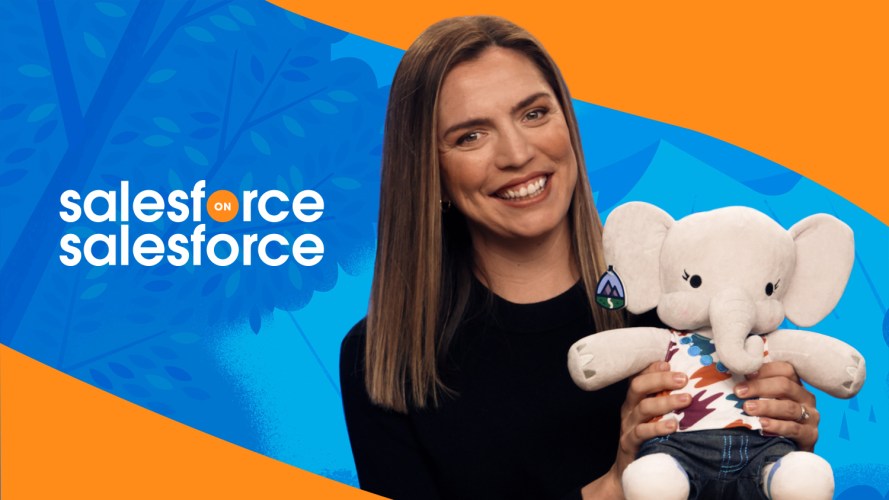5 Simple Steps To Delivering Better Product Demos



Use these five tips to plan and execute demos that help your audience fully understand your product vision and capabilities.

Gabe Sumner
I admit I’m a little biased, but I think the product demo is the most important part of a marketing strategy. It’s a chance to put your product’s best qualities in the spotlight, answer questions, and turn naysayers into believers.
I’ve been doing product demos at Salesforce for a long time, and I’ve learned there’s nuance to delivering great presentations. Often, presenters are tempted to just reuse marketing positioning language. But at this stage in the marketing journey, your audience has probably already heard that through a launch presentation or online content.
Perhaps they still have questions, or they’re skeptical about a product’s capabilities. It’s your job to change their minds now, or they’re going to bounce to a competitor. No pressure, right?
Product demos should answer questions like, “How does this product work?” and “How will it benefit my business?”
These questions are often rooted in confusion and doubt. The goal of a product demo is to build confidence and enthusiasm by showing audiences exactly what they’ll be getting. And if you do this job really well, you’ll also make them feel great about the opportunities this product makes possible.
You can drastically improve your demos by honing a few simple but important steps. Here are five practical tips for creating product demos that audiences love.
Download our product demos planning template
Use this worksheet to map out your demos from start to finish.n



1. Plan a big question that your product demo will answer
It’s easier to ask a question than to write an answer at the beginning stages of a project. A great question will inspire a great answer. And this question will continue to be useful throughout the whole process, from planning to presentation.
As you collaborate with new internal stakeholders, you can start by saying, “Here’s the question we’re trying to answer in this product demo.”
Talented teams don’t need to be told what to do; they just need to understand what you want to achieve. A great question can succinctly express your objective and spark the team’s imagination. It will also grab your demo audience’s attention.
So what makes a question great? Great questions are evocative. They inspire the listener to wonder or imagine.
Here are a few examples of thought-provoking questions:
What if your most common business process took half as many steps to complete?
What if you were sent a warning just prior to making a mistake?
What if it cost $5 to switch to a new browser tab?
These questions make the audience think about how their jobs – and lives – could be improved.
And from there, they can begin to see a story with solutions. This is why these questions are so useful in the first few minutes of the demo.
2. Identify the purpose of your product demo
Great demos deliver clear takeaways, but doing this requires focus. First, we need to resist the temptation to show everything. Check out the overload in this example:
“In this demo, I’m going to show you how the Salesforce Platform enables you to build, automate, and secure using low code.”
There are actually three takeaways here: build, automate, and secure.
Remember, the product demo’s job is to address doubt and confusion. And it’s going to be very challenging to do this if you have three different takeaways.
So let’s try being more focused. For example:
In this demo, I’ll show you how Salesforce Flow helps you use automation to make your business processes more efficient.
Now I’m only focusing on automation, which makes it easier for the audience to digest and appreciate.
Set yourself and your audience up for success by focusing the takeaway.
Develop a game plan for better product demos
Salesforce’s Gabe Sumner explains how to create demos that turn doubters into believers.n



3. Visually introduce the use case for your product demo
Your audience needs to see how the product works. But how do we get them to connect the talk track and visuals? I use the phrase, “Here you’re looking at…” to hammer that home.
For example:
Here you’re looking at a mortgage application that one of our customers just submitted.
Notice I’m clearly pointing out what the audience is seeing. And I’m using that visualization to set the context and use case that the demo will dig into.
4. Identify the challenge your product addresses and the outcome it makes possible
Now it’s time to take the audience on a journey. And there can be no journey without contrast. We need to go from somewhere to somewhere.
This means we need to envision life without our products and then show the improvement our products make possible.
So let’s return to our example:
Here you’re looking at a mortgage application that one of our customers just submitted. It involves dozens of manual steps. And as a result of this inefficiency, our customer satisfaction scores were plummeting.
Finally, we cut the number of steps involved in processing one of these applications in half. And as you can see, our satisfaction scores have never been higher.
Notice the contrast between these two points. This is important because our demo’s finish will only be as delightful as our beginning was painful. Simply put, high highs require low lows.
5. Show how your product enables the journey from challenge to solution
Imagine showing someone a picture of a dilapidated house. Then imagine showing a picture of an immaculate house and saying, “We help you make this happen!” Their natural question will be, “How?”
It’s not enough to show your audience the before and the after. To have credibility, you must show the journey between those two points.
Every great demo shows its audience how the product helps them get from challenge to solution. But how do we bridge these two points?
I use three magic words to get from problem to solution: Because, Therefore, and But.
What makes these words so special? They force presenters to acknowledge what just happened before showing the next step.
For example:
Our business process is inefficient. Because of that, our satisfaction scores are plummeting. And therefore, we’ll use Salesforce Flow to create a new workflow. And because of that, we’ve eliminated many of these steps with automation.
You don’t have to literally say these words over and over in your talk track. Just be mindful of the philosophy to connect each step in your demo. This connectivity helps your audience follow the story.
You want your audience to experience what’s possible with your product. They should leave the demo feeling inspired. Even if your audience doesn’t remember every detail of your presentation, they’ll remember what the experience felt like. They’ll feel that life will be better with your product.
Those are my five tips for memorable live product demos. I’ll leave you with one more: Have fun during your presentation. If the audience senses that you believe in your product and are excited about it, they’ll believe in it and be excited, too. And your customer relationships will be better for it.
Learn the basics of product demos
Visit our Trailhead page to get started on your strategy.


























